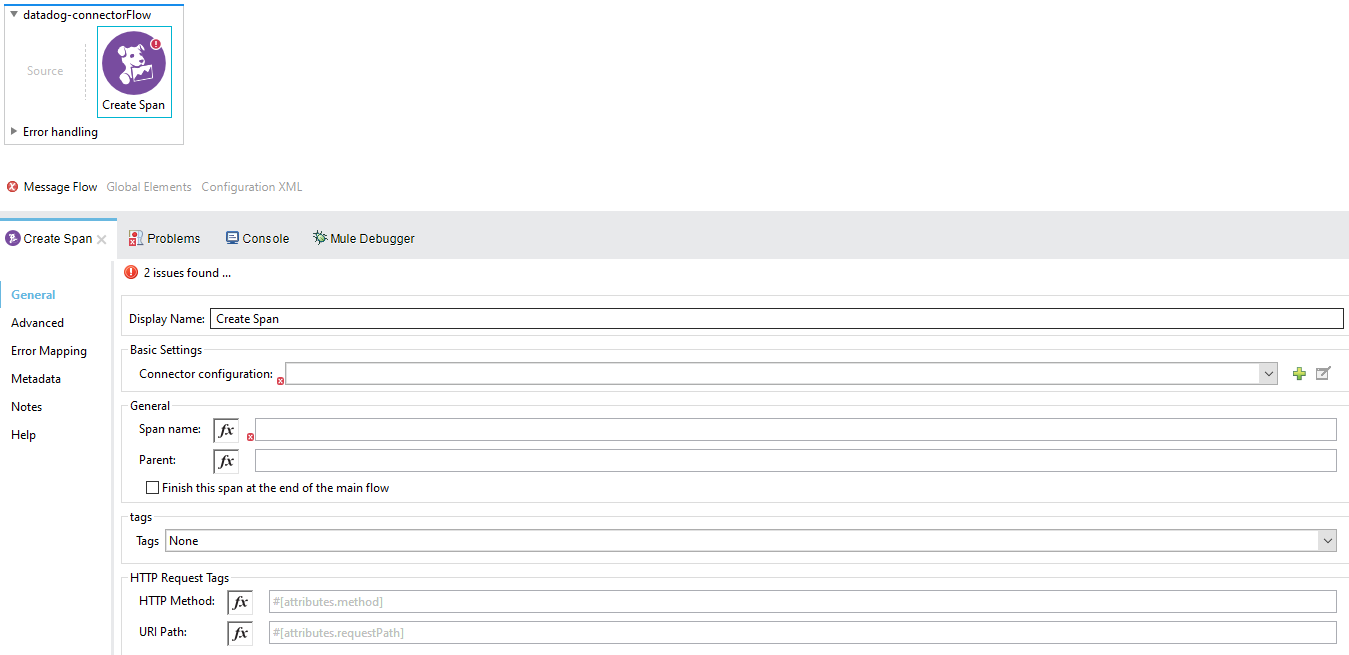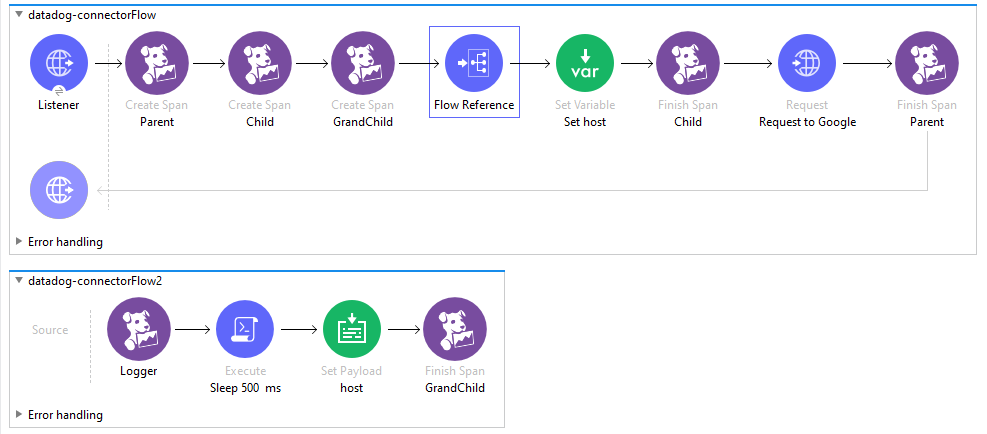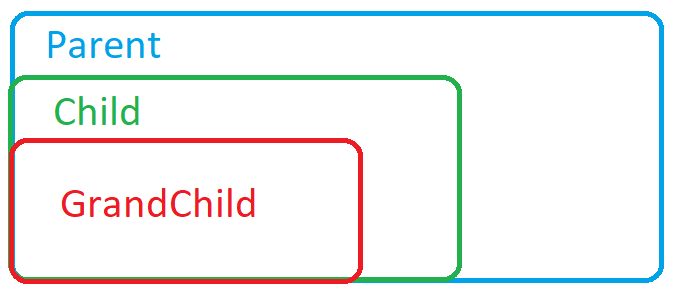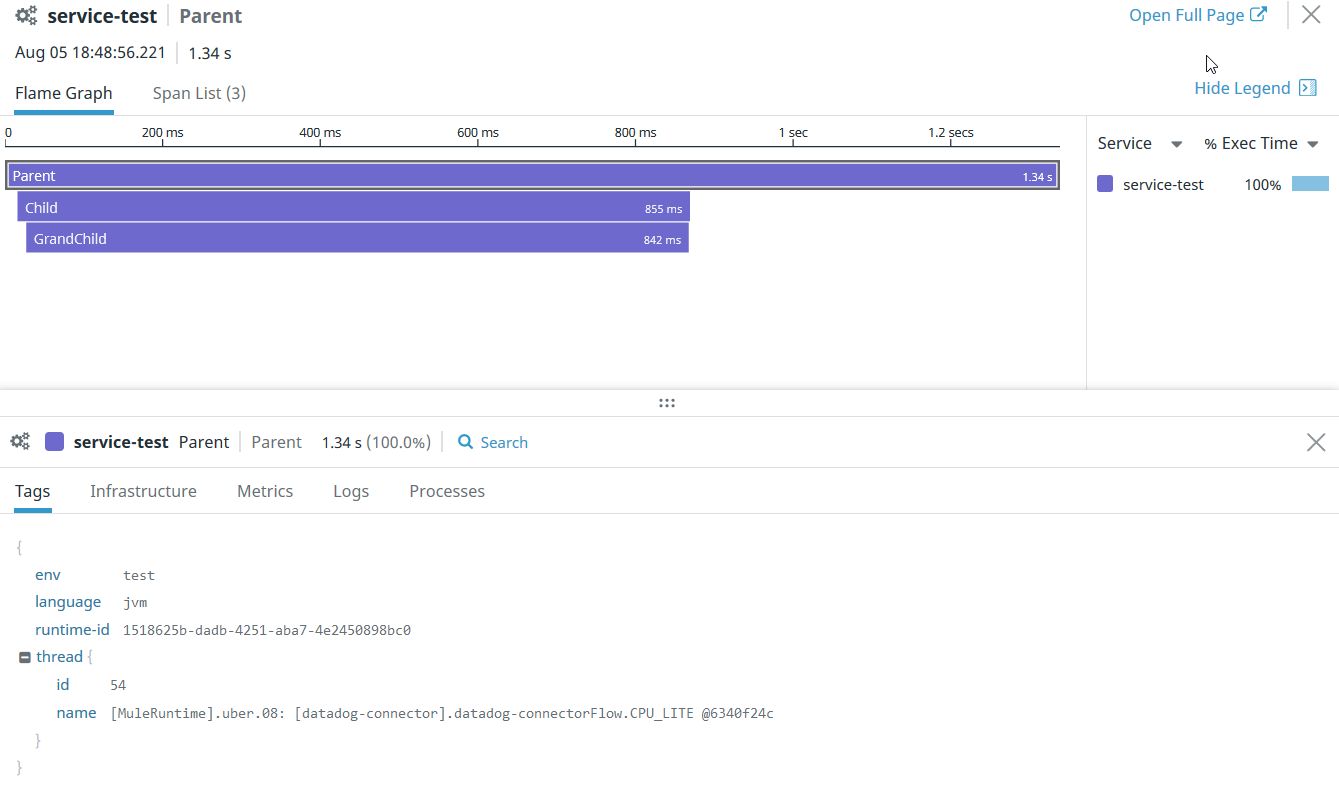Datadog Mule Integration 4 APM
Operations
Create Span
The create span operation as states, creates a new span in the flow, it will run in the flow until it gets finished. A span can contain Children, and those Children as well can contain Children and so on, this is useful to add granularity to the project.
The operation looks like this:

-
Display name: By default is displayed as Create Span.
-
Connector configuration: This is where the Datadog Global Configuration is set, required.
-
Span name: required.
-
Parent: The parent of the created span, optional.
-
Finish this span at the end of the main flow: This checkbox ensures that the span will be closed automatically at the end of the flow execution, the default is unchecked.
-
Tags: These are key-value pairs that can be set Inline or with DataWeave expressions, this provides labels attached to the spans that are created in execution time, optional.
-
HTTP Request Tags: Additional info the user can provide to the span, in this case the HTTP Method and the URI Path in case the user may require it for REST Services. Accept DataWeave expressions as well as static values. optional.
The following is an example of how to assign a child span to a parent. This flow will be used as the main example thoughout the different operation explanations. Let’s check how this can be useful.

There are 3 spans created in the flow: Parent, Child, and GrandChild
The main span is called Parent, then in the Child span we assign the Parent field as Parent, which is the name of the first span created, and finally, we assign GrandChild span Parent field as Child.
With this we have the following hierarchy:

Parent will contain Child, at the same time Child will contain GrandChild.
If we run the following flow and go to the Datadog APM, the result is this trace:

And here the spans created:

As you can see, Child and GrandChild are nested to the Parent. Nesting can have n level.
The Create Span element sets a Span with a name, this span will run as soon as is created in the flow, can have a parent and fields for tags.
<flow name="datadog-connectorFlow" >
<datadog-apm:create-span config-ref="Datadog_APM_Config" spanName="Span" parent="Parent of this span" method="GET" path="/services/traces" autofinish="false">
<datadog-apm:tags >
<datadog-apm:tag key="key" value="value" />
</datadog-apm:tags>
</datadog-apm:create-span>
</flow>
Distributed tracing
Context Injection
- None: No injection information.
- Edit Inline: Define properties for trace information.
- Trace ID: (Required) to specify the trace ID of the propagated trace to correlate the trace to be created
- Parent ID: (Required) to specify what ID is our parent, we need the parent ID to successfully create the context of the trace to create.
- Sampling Priority: Used for sampling rules by priority contains a numeric value
- Baggage Items: The Baggage items are the tags propagated from other traces to your trace to create. This is a Map of string, string, representing the key and value to get the baggage items. A common example of a propagated tag could be orderId or customerId.
Note: Ensure baggage item values are not null. Use DataWeave expressions with “#[]” for transformations.
Context Propagation
The context propagation section is where you will set the tags you want to distribute. All the tags defined here will be shown in Datadog platforms as normal tags but also will get in the Create Operation response with the next format “ot-baggage-TAG-NAME”, and you can use it to propagate to your other apps.
When you set baggage items you can define it as next. The baggage items in context propagations is a Map of string, string, representing the key and value. A common example of a propagated tag could be the correlationId or customerId.
Note: If you set a property to define a baggage item you need to ensure that the value is not null.
DataWeave expressions are not set by default, you need to define the “#[]” before using a DataWeave transformation.
Parameters
|
Name |
Type |
Description |
Default Value |
Required |
|---|---|---|---|---|
|
config-ref |
Configuration |
Global configuration element of the operation |
|
x |
|
spanName |
String |
Name of the span to be created |
|
x |
|
parent |
String |
Name of a span that will act as the parent of the one created in this operation |
|
|
|
method |
String |
HTTP Method to be inserted in the span |
|
|
|
path |
String |
Path to be inserted in the span |
|
|
|
tags |
Map |
Key-value pair of tags that can be inserted in the span |
|
|
|
autofinish |
Checkbox |
Indicates if span will be auto finish at the end of the flow |
false |
|
|
Trace ID |
String |
Trace ID for context propagation |
|
x |
|
Parent ID |
String |
Parent ID for the next trace |
|
x |
|
Sampling priority |
Int |
Used for sampling rules and rates |
|
|
|
Baggage items |
Map |
Tags distributed through all spans |
|
|
|
Baggage items |
Map |
Tags distributed through all spans for context propagation |
|
|
Output
“Create Span” Operation now returns a HashMap Object
In APM Connector versions < 3.0.0 the Create operation returns a void element, but this changed with this update. Now we return a HashMap object of a key, value pair representing the span context of the created object. The objective of this have the ability to distribute the span to different applications. This means we will be able to propagate our trace updates in our apps.
When you use the Create operation you will get the next parameters. They are the same fields that you get with the create operation:
- x-datadog-trace-id: this field has the trace id. You will use this trace ID to propagate the context to other apps and correlate the next trace to be created
- x-datadog-parent-id: You can use this field to specify the parent of the next traces.
- x-datadog-sampling-priority: This property is used when you are using sampling rules and rates.
- ot-baggage-…: All elements starting with “ot-baggage-“ are tags that will be distributed through all our spans.
Note: Since the Update operation now returns an object, the payload will be overridden. Store the result value in a target variable. See the "Recommendations Using the APM Connector 3.0.0" article.
Finish Span
The Finish Span element finishes a span already created in the flow, sending this span to the Datadog APM view with its respective timestamps, contains the global configuration and the span name to be finished.
<flow name="datadog-connectorFlow" >
<datadog-apm:finish-span config-ref="Datadog_APM_Config" spanName="Span to be finished" error="false" statusCode="200"/>
</flow>
Parameters
|
Name |
Type |
Description |
Default Value |
Required |
|---|---|---|---|---|
|
config-ref |
Configuration |
Global configuration element of te operation |
|
x |
|
spanName |
String |
Name of the span to be finished |
|
x |
|
error |
Boolean |
Check if the span is marked as error |
false |
|
|
statusCode |
Integer |
Set the status code of a span if stated |
|
|
Update Span
The Update Span element updates a span already created in the flow, adding tags to add more optional information between the creation and closure of it.
<flow name="datadog-connectorFlow" >
<datadog-apm:update-span config-ref="Datadog_APM_Config" spanName="Span to be updated"/>
</flow>
Parameters
|
Name |
Type |
Description |
Default Value |
Required |
|---|---|---|---|---|
|
config-ref |
Configuration |
Global configuration element of the operation |
|
x |
|
spanName |
String |
Name of the span to be updated |
|
x |
Output
“Update Span” Operation now returns a HashMap Object
In APM Connector versions < 3.0.0 the Update operation returns a void element, but this changed with this update. Now we return a HashMap object of a key, value pair representing the span context of the created object. The objective of this have the ability to distribute the span to different applications. This means we will be able to propagate our trace updates in our apps.
When you use the Update operation you will get the next parameters. They are the same fields that you get with the create operation:
- x-datadog-trace-id: this field has the trace id. You will use this trace ID to propagate the context to other apps and correlate the next trace to be created
- x-datadog-parent-id: You can use this field to specify the parent of the next traces.
- x-datadog-sampling-priority: This property is used when you are using sampling rules and rates.
- ot-baggage-…: All elements starting with “ot-baggage-“ are tags that will be distributed through all our spans.
Note: Since the Update operation now returns an object, the payload will be overridden. Store the result value in a target variable. See the "Recommendations Using the APM Connector 3.0.0" article.
Activate Span
The Activate Span element sets a span as the new active one, measuring all the current performance in the flow, contains the global configuration and the span name to be activated.
<flow name="datadog-connectorFlow" >
<datadog-apm:activate-span config-ref="Datadog_APM_Config" spanName="Span to be activated"/>
</flow>
Parameters
|
Name |
Type |
Description |
Default Value |
Required |
|---|---|---|---|---|
|
config-ref |
Configuration |
Global configuration element of the operation |
|
x |
|
spanName |
String |
Name of the span to be activated |
|
x |
Finish All
The Finish All element sets all the spans created to finished at once, this operation is executed based on a LIFO structure, contains the Global configuration
<flow name="datadog-connectorFlow" >
<datadog-apm:finish-all config-ref="Datadog_APM_Config"/>
</flow>
|
Name |
Type |
Description |
Default Value |
Required |
|---|---|---|---|---|
|
config-ref |
Configuration |
Global configuration element of the operation |
|
x |
Logger
The Logger element creates information to be logged to the stated span in the Span Name field, sending information that can be consulted in the Datadog APM view, contains the Global configuration, the span name, a message, the logging level to be chosen, and the category. This logger operation is designed to help correlating the produced log with the parent trace Id in Datadog APM.
<flow name="datadog-connectorFlow" >
<datadog-apm:log config-ref="Datadog_APM_Config" spanName="span to be logged" message="message" category="category of the log" level="ERROR"/>
</flow>
|
Name |
Type |
Description |
Default Value |
Required |
|---|---|---|---|---|
|
config-ref |
Configuration |
Global configuration element of the operation |
|
x |
|
spanName |
String |
Name of the span in which the logs will be inserted |
|
x |
|
message |
String |
Message to be inserted in the span |
|
x |
|
level |
Enumeration, one of:
|
Logging level of the log |
INFO |
|
|
category |
String |
Label to classify the log |
|
|